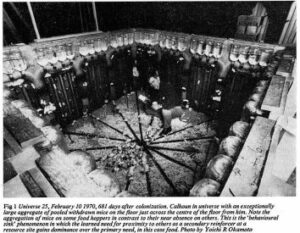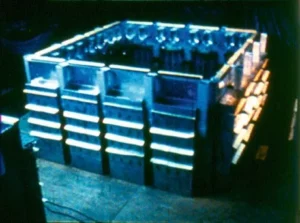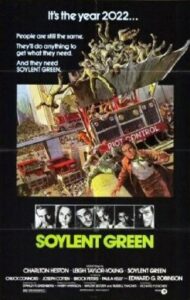
John B. Calhoun relaxing in Universe 25
In the late 20th Century, John B. Calhoun decided to make Utopia; it started with rats. In 1947 he began to watch a colony of Norway rats, over 28 months he noticed something, in that time the population could have increased to 50,000 rats, but instead it never rose above 200. Then he noticed that the colony split into smaller groups of 12 at most. He continued to study rats up until 1954. Then in 1958, he made his first lab.
He bought the second floor of a barn, and there he made his office and lab. For four years he had Universe 1, a large room hosting rats and mice alike. It was split into four spacious pens connected by ramps, each filled with rats. The thronging mass of rodents produced an odour so strong that unaccustomed visitors took several minutes until they could breathe normally. In 1963 he produced his most famous creation, Universe 1. The worlds first mouse mortality-inhibiting-environment.
2.7 metres square with 1.4m high walls. The ‘Universe’ was surrounded by 16 tunnels leading to food, water and burrows. No predators, no scarcity, the mice would have to be blind to not see the utopia around them. At least it began as Utopia. Four breeding pairs of mice were introduced into Universe 1. After 104 days they adjusted to the new world and the population began to grow, doubling every 55 days. By day 315 the population reached 620. Then is stopped. The population grew much more slowly as the mice came against the limit of space, their only limiting frontier.
Society broke. Young were expelled before they had been properly weaned and were arbitrarily attacked by excessive aggressive male mice. Females became more aggressive, non-dominant males became passive, not retaliating to attacks. The last healthy birth came on the 600th day. Then there were no new mice. Then there were none.

The outside of Universe 25
The purpose of the experiment for Calhoun was to examine a pressing problem, overpopulation. In the post-war 1940′s the world population was rising extremely quickly and in the 1970′s this continued. The question was, what happens next? So he tested it, and tested again. Just 9 years later, in 1972, he produced Universe 25, similar in design but so precise as to keep the temperature at a constant 20 degrees. No matter how he adjusted the ‘Universe’ the results were consistent, the mice moved from perfect to appalling.
After day 600, the male mice just stopped defending their territory, listless mice congregated in the centres of the Universe. These gangs would burst into pointless and sporadic violence. Females stopped reproducing and even started attacking their own young. Mortality rose phenomenally. Roaming mice either attacked or attempted to mount others, irrespective of relation or gender, cannibalism and other acts of depravity consumed them. These were the feral ones. Then there were the ‘beautiful ones.’
The ‘beautiful ones’ withdrew themselves ever so quietly, removing themselves from the sick society. Solitary pursuits began to define them; eating, drinking and grooming among others. No scars on their back or hairs out-of-place, these mice behaved like a separate race. They saw the world through their narrow scopes, as they tossed, turned and tried to cope.
In the end the population sank, even when it was back down to a tolerable level none of the mice changed back. The change was irreversible, the mice were different now. The secluded females could still bear offspring and the beautiful ones had the capacity to help produce them yet it never came. This tipping over into irreversible societal collapse came to be known as ‘The Behavioral Sink.’ John Calhoun called it the first death. Death of the mind and soul, leading eventually to the second death, of the physical form. What he meant was that after the first death, the mice were no longer mice and could never be so again.

Poster for dystopian film Soylent Green
In a time where people worried about the dangers of people gathering in cities it confirmed their worst fears. The paper, when published, was a massive hit as papers go, it fed into the public consciousness and seemed to match up with the worst of the worries. In 1973, the same year in which the paper was published, the film Soylent Green was released. It depicted a future, an overcrowded world where the population could only survive on Soylent Green, a food handout from the government. The source it turns out, was the more than plentiful supply of human corpses. This change, this innovation was reflected in his experiments. From the cannibalism to the behaviour in desperate mice, John Calhoun noticed that some mice, feral though they were, had to innovate to survive, they became creative.
This purpose of the experiments was not to portend some imminent doom for humanity, in fact Calhoun was trying to be positive. He wanted to change cities, his remedy to the behavioural sink was creativity. By changing society and changing how we designed our cities we could avoid becoming mired, stagnant, and eventually, dead as a dormouse. Over 100 Universes were designed after he published the paper in 1973, these ones designed with the aim of promoting creativity and reducing stagnation.
The fact that nearly everyone who read his research used it to draw out doom caused John Calhoun to become distraught. They missed his point, but still he pressed on. Regardless of what was said, there was science to do. He and others promoted space colonies as a way of advancing human societies and he convinced others to change the way they thought of cities. Bringing in the idea that the places in which people lived could affect their lives in the way they were designed.
For the first time in history, over 50% of the world population exists within cities, and they are safer than ever before, due in part to the ideas drawn from John B. Calhoun and his pungent rodents. His 1973 paper has been classed as one of the 40 most influential psychology papers of all time, and with good reason, it may have indirectly saved thousands of lives.
Further Reading
